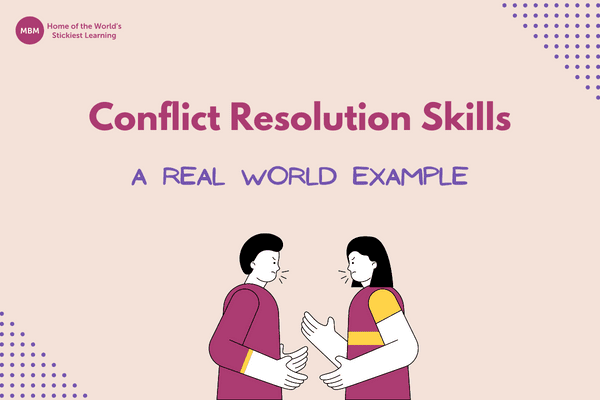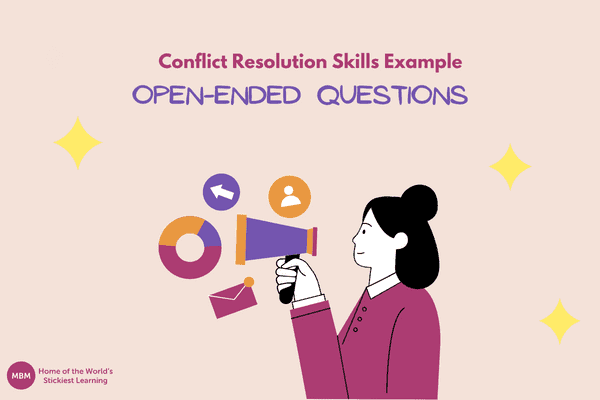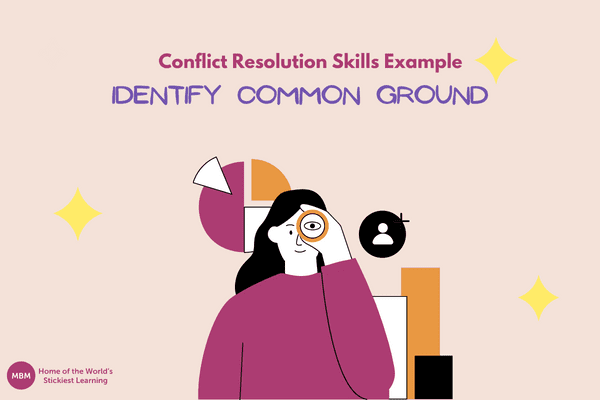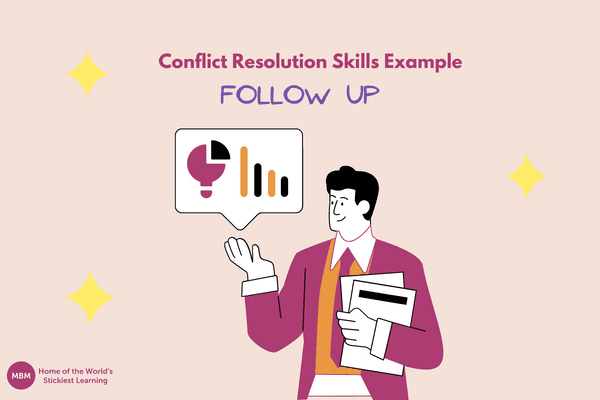Preventing and Resolving Conflict at Work With Examples
You’re a manager interested in conflict resolution skills examples. I get it. That’s understandable since as people, we are generally not very good with conflict.
With caveman-type physical solutions now somewhat… frowned upon, we are left with the slightly awkward, very uncomfortable ‘verbal communication.’ I know… gross. I mean who even does that these days?
OK, jokes aside, we all actively avoid conflict for the majority of the time because it is quite plainly easier to just carry on. Sometimes this can work as you slowly forget why you were annoyed about something. If this happens, keeping quiet was probably the best thing to do. It clearly didn’t end up being a big deal.
Sometimes, however, conflict just needs to be dealt with head-on. All natural instincts to throw a tantrum and become petty must be ignored and we must simply find a decent solution in a mature way.
So, how do we get past the awkwardness of conflict? How do we approach the situation without it blowing out of proportion? Sit tight, my friend. We shall walk through the answers to these questions and even a few more.

A Real World Example
I find it helps to have an actual example to call back to as I explain these conflict resolution skills. So here’s a quick story taken from a previous hospitality job.

I worked a bar job for a few months over the summer between semesters at University. It was a quaint little place on the river with a beautiful garden in the summer and… terrible customer reviews.
The place got slated on a weekly basis. Needless to say, it was soul-destroying work being part of such a poorly reviewed team. The main issue? A lack of staff.
My boss had been advertising for weeks and finally got a phone call. She ended up hiring a new waitress within a couple of days. The waitress – lovely girl… terrible, terrible waitress. She had zero experience and worse, zero work ethic or care for anything we were doing.
Ironically, my boss hired a new team member and everyone else ended up working twice as hard to account for the new recruit’s mistakes and lack of sh*t-giving. It didn’t take long to get under my skin. This waitress had no intentions to pull her weight and didn’t seem to care that everyone else had to work harder to make up for that.
What Was I to Do?
Well, I had three options; keep quiet, talk to her directly, or talk to my boss.
I didn’t choose, I simply did all three.
First, I kept quiet for another few shifts to see if things would change – they didn’t. Then I spoke to the waitress, very politely, and said it would be great if she could do some things without being asked several times.
After a while of no change, I went to the boss. ‘Either she’s gone or I am, I can’t work with this person anymore.’
I quit three days later.
This was not a demonstration of good conflict management by any of the involved parties, including myself. It was not made clear to each party what the issue was, it was not prevented by the boss in the first place and no clear resolution was reached by all parties together.
Yes, it was a recipe for disaster. Not surprising, my irritation with this waitress far surpassed my rational problem-solving. It was dealt with horribly, I ended up losing a job.
Gain a clear visualisation of how you can prevent a similar situation from happening with these conflict resolution skills examples.
5 Conflict Resolution Skills Examples
1. Do Not Avoid It!
The easiest, or what seems to be the easiest, solution to conflict is simply not to get involved in it. This is especially when it does not directly involve you.
Whilst, in the short term, it is much easier to stay away from this conflict, it will absolutely come back to bite you… the undercooked chicken. The problem will grow, the involved parties will get increasingly irritated with its lack of solution and, before you know it, things are really bad. So remember to always, always face the problem head-on.
Skill Example: Active Listening

Active listening is a critical component of effective conflict resolution. It involves paying close attention to what the other person is saying and showing empathy and understanding towards their perspective. By actively listening, a manager can demonstrate to the conflicting parties that their concerns are being heard and that their opinions are valued.
For example, if two employees are in conflict over a particular project, as manager you can have a one-on-one conversation with each employee to understand their perspectives. Managers can listen actively by making eye contact, nodding in agreement, and summarising the employees’ concerns to ensure they have been heard accurately.
2. Clarify the Issue First
Another conflict resolution skills examples is clarifying the issue. It is easy to jump to conclusions and pick sides. But of course, you want to avoid this like the plague because it will only cause more problems. Try to talk to all involved parties individually and get a well-rounded perspective on the issue at hand.
Skill Example: Open-Ended Questions

Open-ended questions cannot be answered with a simple “yes” or “no.” By using open-ended questions, a manager can encourage the conflicting parties to provide more in-depth information about their perspectives and motivations. This can help to uncover the root cause of the conflict and provide the manager with a deeper understanding of the situation.
For example, you being the manager can ask open-ended questions such as, “Can you tell me more about what led to the conflict?” or “What are your concerns about this situation?” By doing this, you can gather more information about the conflict and gain a better understanding of the conflicting parties’ perspectives.
3. Bring Involved Parties Together, Quickly
As I mentioned, there is never any point in allowing these things to fester and grow – it will only cause more problems. After getting a good understanding and perspective of the issue at hand from all involved parties separately, you now have the accurate information to bring the problem to a close.
Skill Example: Identifying Common Ground

Identifying common ground is a key step in resolving conflicts. By finding areas of agreement between the conflicting parties, a manager can help to build a foundation for a solution that everyone can support. This can help to create a more positive and productive atmosphere for resolving the conflict.
For example, if two employees are in conflict over a project, you can help to find common ground by identifying areas of agreement. For instance, both employees may agree that the project needs to be completed on time and to a high standard. By identifying this common ground, managers can help to build a solution that both employees can support.
4. Resolution Time
Spend as much time as is required to reach a satisfactory conclusion for all parties. People will want different things and this is OK. Explain that some compromise is going to be required. Keep the conversation light, working quickly through negatives and staying on positives for longer.
Skill Example: Brainstorming

Brainstorming solutions is another critical step in resolving conflicts. By working together to find a solution, managers can help to build a sense of teamwork and collaboration between the conflicting parties. This can also help to reduce tensions and create a more positive atmosphere for resolving the conflict.
For example, as a manager, you can facilitate a brainstorming session with the conflicting parties to find a solution to the conflict. During the session, you can encourage open and honest communication, and encourage the conflicting parties to think creatively and collaboratively. You can also help to guide the discussion and ensure that all perspectives are heard and considered.
5. Monitor With a Close Eye!
Once you have concluded steps one through four, keep in mind that the conflict is not over! You will be able to tell whether it was an issue that is likely to arise again or whether it is not.
Either way, do keep an eye on further conflict arising between those specific employees and also surrounding that particular issue in general. Others may have an issue with it as well. Take a quick look at what the issue was about – maybe there is something you can do to prevent anyone from experiencing the same issue and, thus, conflict arising thereof.
Skill Example: Follow-Up

Follow-up is an important step in ensuring that the conflict is fully resolved and that the solution is implemented effectively. By following up, a manager can ensure that the conflicting parties have implemented the agreed-upon solution and that the conflict does not re-emerge in the future.
For example, after a conflict has been resolved, as a manager you can schedule a follow-up meeting with the conflicting parties to review the progress of the solution and ensure that everyone is satisfied with the outcome. You can also encourage the conflicting parties to communicate openly and honestly about any challenges or concerns they may have, and work together to find a resolution.
Now, you have a toolkit for both the prevention and resolution of workplace conflict. Make sure your chicken is cooked and follow the required steps should the oven not quite get up to temperature! Good luck.
Follow us on Linkedin.




